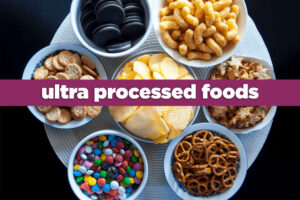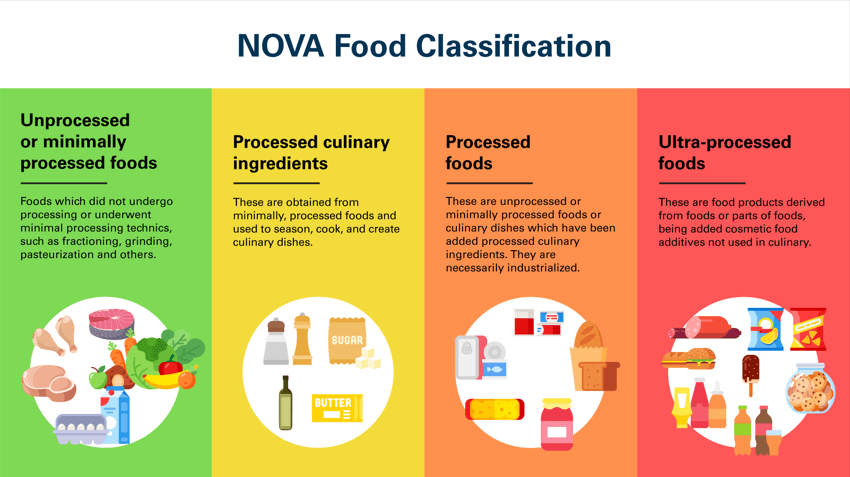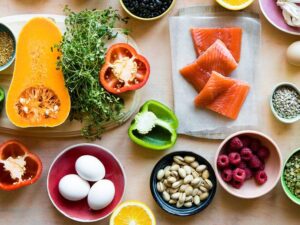What Are Ultra-Processed Foods?
I started telling people to limit their consumption of processed foods when I wrote our first nutritional program in 2008. I didn’t really know how to define processed foods. I also didn’t realize that almost all foods undergo some sort of processing.
After reading Michael Pollan’s book In Defense of Food in 2009, I realized that most of the foods in the supermarkets were processed in an industrialized way that make us sick and fat. Pollan’s well-defended belief is that “chronic diseases that kill most of us can be traced directly to the industrialization of our foods: the rise of highly processed foods and refined grains; the use of chemicals to raise plants and animals in huge monocultures; the superabundance of cheap calories of sugar and fat produced by modern agriculture; and the narrowing of the biological diversity of the human diet to a tiny handful of staple crops, notably wheat, corn, and soy.”

Most of what we consume today isn’t food. It’s better described as “edible food-like substances” that are the products of science, not nature. Many of the foods in grocery stores have a health claim on their label, which should be our first clue that they are anything but healthy.
In 2018, when I wrote our Simple 9© nutritional program, Pollan inspired me to keep telling people to avoid foods that are “too processed.” By then I realized that most foods are processed in some way. But how much processing is too much? I came up with what I thought would be a simple rule to tell whether a food was too processed:
Only eat processed foods that contain 7 or fewer familiar, pronounceable ingredients. The most important fact about any food is not its nutrient content, but its degree of processing. There are really only two food groups you need to be concerned with: whole foods and industrial foods.
I’ve always thought what I wrote was good, but not quite good enough. Foods can have more than 7 ingredients and not be too processed.
In 2009 Carlos Augusto Monteiro cited Michael Pollan as an influence in coining the term “ultra-processed food.” Monteiro, a nutrition researcher, noticed a significant increase in obesity rates among economically disadvantaged populations in his home country Brazil in the 1990s. Monteiro’s research led him to discover two distinct eating patterns in Brazil: one rooted in traditional products like rice and beans and another characterized by the consumption of highly processed products.
Monteiro believed that food processing had led to the obesity epidemic he saw in his country. To help people understand what to eat and what to avoid, he and his colleagues developed the Nova food classification system of four groups of food defined according to the nature, extent, and purpose of industrial food processing applied.

Group 1: Unprocessed or minimally processed foods
Unprocessed foods are edible parts of plants and animals.
This group includes minimally processed foods modified by removing unwanted parts, crushing, drying, fractioning, grinding, pasteurization, non-alcoholic fermentation, and freezing. This group contains no additives like salt, sugar, oils, or fat.
Group 2: Processed culinary ingredients.
Derived from group 1 foods by processes such as pressing, refining, grinding, milling, and drying. These ingredients are typically used to season group 1 foods.
Examples include oils produced through crushing seeds, nuts, or fruits (such as olive oil), salt, vinegar, starches, honey, syrups extracted from trees, butter, and other substances used to season and cook.
Group 3: Processed foods
Relatively simple food products produced by adding processed culinary ingredients such as salt or sugar to unprocessed foods.
Processed foods are made or preserved through baking, boiling, canning, bottling, and non-alcoholic fermentation.
Examples include cheese, canned vegetables, salted nuts, fruits in syrup, and dried or canned fish. Breads, pastries, cakes, biscuits, and some meat products fall into this group when they are made predominantly from group 1 foods with the addition of group 2 ingredients.
Group 4: Ultra-processed foods
Formulations of ingredients typically created by a series of industrial techniques and processes. Unprocessed foods often compose a small proportion of their ingredients or are even lacking entirely. Ultra-processing introduces food substances of little or no culinary use, such as hydrogenated oil, modified starch, protein isolate, and high fructose corn syrup.
Examples include carbonated soft drinks, reconstituted fruit juices, margarin, reconstituted meat products, plant-based meat substitutes, and some breakfast cereals. Certain bakery items, snacks, flavored yogurts, candies, and ready to eat dishes also fall in this category.
In 2012, French programmer Stephane Giganet, was inspired by Jamie Oliver’s food revolution day to organize an online database that ranks foods based on the Nova food classification system.
 The Open Food Facts database ranks over 3 million different foods from around the world. They have a free downloadable app that allows you to scan the barcode on any food and instantly get its Nova ranking.
The Open Food Facts database ranks over 3 million different foods from around the world. They have a free downloadable app that allows you to scan the barcode on any food and instantly get its Nova ranking.
A study published in 2015 in the British Medical Journal found that 58% of the foods American’s eat are ultra-processed. Most of the food we eat isn’t real food. We eat a lot of industrial products manufactured by the food industry designed to be low cost, convenient, and hyperpalatable. This makes most of the foods we eat cheap, fake, and highly addictive.
I highly recommend downloading the Open Food Facts database app to help you evaluate whether a food is ultra-processed or not. But if you don’t want to bother with an app, a few practical guidelines will help you spot ultra-processed foods.
- If your great grandmother wouldn’t recognize it as a food, don’t eat it. Pretty simple, right? Your great grandmother would have had access to about 100 different foods throughout the seasons of the year. Now, the average grocery store contains more than 40,000 different items, most of which are not real food.
- If a food contains any ingredients you wouldn’t cook with in your home, don’t eat it. It’s not real food. I know this might sound a little extreme, but I don’t think it is. Read food labels. If the label contains anything in the ingredients list you don’t recognize, can’t pronounce, or you don’t know what it is, don’t eat it. Your body won’t know what it is either.
- If it won’t spoil in a week or so, you probably shouldn’t eat it. I know there are a few exceptions to this rule like pickles, rice, or oats. And there are some great processed whole food snacks. But as a general rule, real food doesn’t last long.
In my opinion, ultra-processed foods are the main cause of the obesity epidemic. We are becoming sick and fat because of them. Let’s all do our part to make things better by not supporting industrialized food and staying away from anything that’s ultra-processed.
Stay Strong,
Bo Railey

